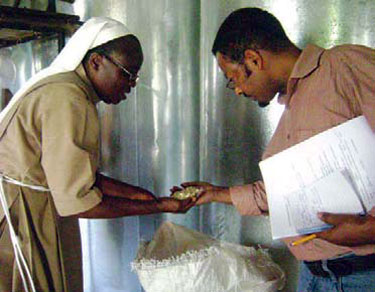 Would you store grain in a metal can? That was the question posed during a humorous skit presented at a stakeholders’ workshop in Homa Bay, Kenya. The can in question is the metal silo and the performance was part of an awareness exercise organized by the Catholic Diocese of Homa Bay. The diocese partners with CIMMYT in the Effective Grain Storage project, where CIMMYT previously facilitated the training of artisans. The project has since continued its work on improved grain storage and creating awareness about the metal silo.
Would you store grain in a metal can? That was the question posed during a humorous skit presented at a stakeholders’ workshop in Homa Bay, Kenya. The can in question is the metal silo and the performance was part of an awareness exercise organized by the Catholic Diocese of Homa Bay. The diocese partners with CIMMYT in the Effective Grain Storage project, where CIMMYT previously facilitated the training of artisans. The project has since continued its work on improved grain storage and creating awareness about the metal silo.
Forty-five participants attended the April 2010 metal silo workshop, including government officials from the Ministry of Agriculture, representatives of nongovernmental organizations, community-based organizations, and artisans, as well as Tadele Tefera, Effective Grain Storage project coordinator, and Judie-Lynn Rabar, CIMMYT-Kenya science writer/editor. Also present were representatives of a local bank, who spoke about the micro-finance opportunities available for agricultural produce, including the metal silo.
The metal silo is gradually gaining ground in the Homa Bay area as a viable postharvest storage technique. This was evident from responses and reactions by both users and artisans. Take the case of Sister Barbara Okomo, the principal of St. Theresa’s Girls’ Secondary School. She is an ardent supporter of and advocate for the metal silo as a storage facility for grain, having used them for over five years.
“With other storage methods, we would lose up to 90% of our stored grain—now we lose nothing,” she said. Sister Okomo has 10 silos at her school to store grain used to feed the students throughout the year. In her opinion, local craftsmen would benefit from formal training on fabrication of the metal silo.
Nicholas Omondi is one beneficiary of the training for artisans that was facilitated by CIMMYT. Despite never having heard of metal silos before CIMMYT’s involvement, he is glad that the diocese selected him for training. Apart from his work as a metal smith, he also grows maize on a one-acre plot of land, mainly for subsistence. “I trained in metal work, but my returns were very low. Now that I am trained in making silos, my income has almost tripled,” he said, adding that he advises small-scale farmers, like himself, to try using the silo and assures them that they will not regret it.
 Capacity development
Capacity development